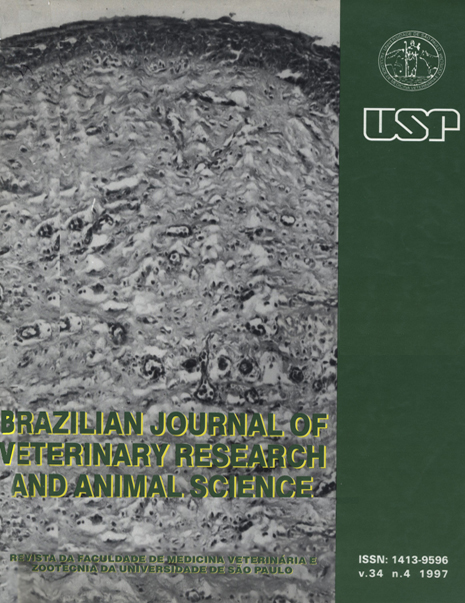Experimental comparison between corneal and conjunctival autogenous grafts in the repair of superficial keratectomies in dogs (Canis familiaris, Linnaeus, 1758). Clinicai and morfological study.
DOI:
https://doi.org/10.11606/issn.2318-3659.v34i4p225-231Keywords:
cornea, surgery, transplantation, dogs, graft.Abstract
Lamellar keratoplasty using fresh autologous grafts of cornea and conjunctiva was studied in thirty one healthy, adult, male and female dogs. Lamellar keratectomies were accomplished removing corneal lamellar bottoms composed of epithelium and half thickness corneal stroma using a 0.5 cm diameter punch (trephine). Grafts were taken from the cornea and autogenous bulbar conjunctiva. They were sutured at the host cornea using an interrupted suture with a number eight ophthalmic silk thread. The graft evolution was evaluated at 1, 2, 7, 15, 30 and 60 days postoperatively. Transplanted corneas showed edema, neovascularization, congestion, hemorrhage, polymophonuclear and mononuclear cells infiltration, and delayed fibrosis. There was a decrease in inflammatory cell infiltrate at the latter evaluation times. By the sixtieth day, the graft areas began to show points of transparency. There were no differences between the procedures studied. The scanning electron microscopy showed epithelization of graft zones within two days of graft implantation. Fifteenth days after surgery, pavement cells were presentat the host areas. By the thirtieth day, the grafted areas were morphologically similar to the normal cornea with granulomatous
tissue around the suture lines. Cytoplasmatic projections similar to that of the normal cornea surface were present at grafted area. The clinical and morphological results with the two techniques employed to repair corneal injuries were similar.
Downloads
Download data is not yet available.
Downloads
Published
1997-08-01
Issue
Section
ANIMAL PATHOLOGY
License
The journal content is authorized under the Creative Commons BY-NC-SA license (summary of the license: https://
How to Cite
1.
Souza MSB de, Laus JL, Morales A, Figueiredo F, Maia J dos S, Valeri V. Experimental comparison between corneal and conjunctival autogenous grafts in the repair of superficial keratectomies in dogs (Canis familiaris, Linnaeus, 1758). Clinicai and morfological study. Braz. J. Vet. Res. Anim. Sci. [Internet]. 1997 Aug. 1 [cited 2024 Jul. 26];34(4):225-31. Available from: https://www.revistas.usp.br/bjvras/article/view/50298





